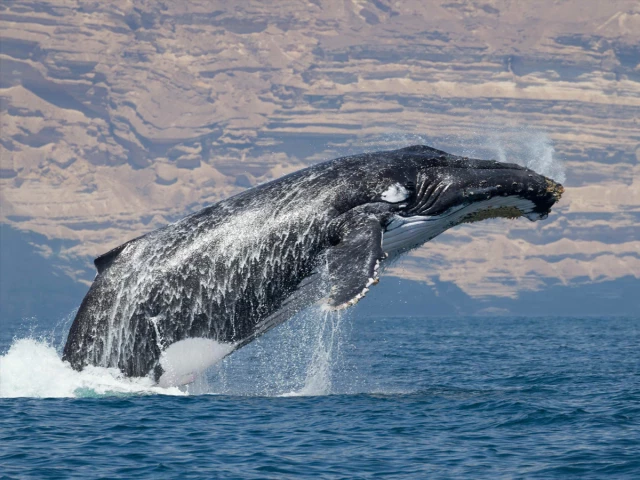Six endangered Arabian humpback whales sighted near Gwadar
Humpback whales found in Arabian Sea are species of baleen whale, after monsoon, they migrate into Pakistani waters

A large pod of endangered Arabian humpback whales has been spotted off the coast of Gwadar, Balochistan — a rare and encouraging sighting for marine conservation. The spectacular moment, where six humpback whales breached the sea surface simultaneously, was recorded on a mobile camera by a fishing boat captain out at sea for the catch.
Humpback whales found in the Arabian Sea are a species of baleen whale, primarily located between Yemen and Sri Lanka. After the monsoon season, they migrate into Pakistani waters to feed on shrimp and other small fish. “The presence of a group of more than six whales is a sign of recovery along Pakistan’s coastline,” said Muhammad Moazzam Khan, Technical Advisor, WWF-Pakistan.
According to WWF-Pakistan, the pod was sighted yesterday evening by a group of fishermen led by captain Amir Dad Kareem, approximately 11 nautical miles south of Gwadar’s coastline, heading west to east through the Arabian Sea.
Just last week, a group of Bryde’s whales was also reported in the eastern bay of Gwadar — further highlighting the rich biodiversity of Balochistan’s coastal waters. So far, 27 species of whales and dolphins have been recorded in Pakistan’s marine habitats.
Khan explained that Arabian Sea humpback whales are unique: unlike many humpback populations that migrate to Antarctic waters in summer to feed on krill, this group remains confined to the Arabian Sea year-round.
Earlier commercial whaling, especially between 1963 and 1967 by Soviet fleets, severely impacted their numbers. “This large pod shows that the dangerously declining population of the Arabian humpback whale may be making a comeback along Pakistan’s coast,” Moazzam Khan said.
WWF-Pakistan Senior Director for Biodiversity, Rab Nawaz, welcomed the recent sightings of humpback whales, as well as repeated observations of Bryde’s and blue whales along the coasts of Sindh and Balochistan.
“We appreciate the fishing community for monitoring whale, dolphin and other marine wildlife sightings and reporting them to WWF. This contribution to citizen science is highly valuable,” Rab Nawaz stated. “Awareness created by WWF among fishermen and the general public is helping protect marine species — which is commendable.”
A majestic species under protection
Marine experts note that humpback whales are among the largest marine mammals on earth. Their ability to produce powerful ocean sounds and their dramatic leaps out of the water make them easily recognizable. Their distinctive hump-shaped dorsal fin and large, beautifully patterned tail allow observers to identify them from far distances.
Humpback whales feed on krill and small marine organisms, trapping their prey in bubble nets before swallowing. As mammals, mother whales nurse their calves for up to a year, making them highly vulnerable to environmental threats. The latest sighting has renewed hope that Pakistan’s waters remain a critical sanctuary for endangered marine life — and that the Arabian humpback whale’s future in the region may yet be secured.



















COMMENTS
Comments are moderated and generally will be posted if they are on-topic and not abusive.
For more information, please see our Comments FAQ